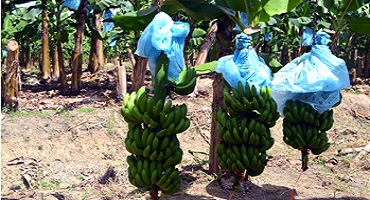 The new Fusarium wilt-resistant Cavendish variants developed by the Taiwan Banana Research Institute and locally tested for adaptability under severely Foc infested farms in Davao Region recently passed the export market standards of China and Middle East.
The new Fusarium wilt-resistant Cavendish variants developed by the Taiwan Banana Research Institute and locally tested for adaptability under severely Foc infested farms in Davao Region recently passed the export market standards of China and Middle East.
The new Fusarium wilt-resistant Cavendish variants developed by the Taiwan Banana Research Institute and locally tested for adaptability under severely Foc infested farms in Davao Region recently passed the export market standards of China and Middle East.
This is a promising result from the joint efforts of the Department of Science and Technology-Philippine Council for Agriculture, Aquatic and Natural Resources Research and Development (DOST-PCAARRD) and other concerned agencies.
Collaborating with DOST-PCAAARRD in the said research and development initiative were the Southern Mindanao Agriculture and Resources Research and Development (SMARRDEC), the Bioversity International, Philippine Banana Growers and Exporters Association (PBGEA), University of the Philippines Los Baños (UPLB), Bureau of Plant and Industry-Davao National Crop Research and Development Center (BPI-DNCRDC), University of Southeastern Philippines (USeP), Local Government Units, and the smallhold banana growers.
Several banana growers from Davao are currently using the moderately resistant Giant Cavendish Tissue Cultured Variant (GCTCV) 218 and highly resistant GCTCV 219. Some growers have already harvested export quality fruits and eventually started exporting abroad.
The planting materials were being distributed to local farmer cooperators through the initiative of the research team.
Microbial agents
Aside from the identification of wilt-resistant Cavendish variants, the research team developed a package of technology effective in managing the disease.
Three microbial agents, Vesicular Arbuscular Mychorrhiza (VAM), Effective Microorganisms (EM), and Trichoderma harzianum, were identified as potential control for the disease. After testing against Foc under greenhouse and field conditions, the three microbial agents successfully reduced Foc Tropical Race 4 (TR4) field incidence.
T. harzianum has controlled Fusarium wilt by 65% in GCTCV 218 while EM reduced the disease by 64%. There is no disease observed on GCTCV 219, proving its strong resistance against Foc. EM reportedly reduced the Fusarium wilt disease by 63%, while the combination of VAM and T. harzianum controlled the disease by 67% across locations in Grand Nain, a highly susceptible Cavendish variety typically grown for export.
Currently, the research team are refining the methodologies on applying the microbial agents in the plants to increase their effectiveness.
Fusarium wilt incidence map
With the improved isolation and quick identification technique using the Polymerase Chain Reaction, Foc TR4 distribution was traced in several provinces in Mindanao such as: Davao del Norte, Davao del Sur, Compostela Valley, Bukidnon, Misamis Oriental, North Cotabato, South Cotabato, Sarangani, and Zamboanga del Norte. Consequently, maps were produced to illustrate the extent of distribution of the pathogen for quarantine purposes.
A Foc TR4 diagnostic laboratory was also established at USEP-Tagum Campus through the support of DOST and PCAARRD.
Regaining ground in the global market
The Philippines remains a top banana producer and exporter in the world. However, local production has been declining for the past years. Among the many reasons accounted for the cutback is the damage caused by insect pests and diseases, and a number of strong typhoons that hit the country.
Through the adoption of technologies generated in the program, DOST-PCAARRD and its partners hope to help the industry regain its strong footing in the global market scene. Specifically, it is hoped to support the growers in rehabilitating their farms and consequently, ensure good harvest and income.
The technologies are intended for the local growers and exporters in Cavendish growing areas in Mindanao, spanning from Regions 9 to 12.
The foregoing research and development initiative in addressing Fusarium wilt is one of the many research and development initiatives in connection with DOST’s Outcome One-to provide science-based know-how and tools that will enable the agricultural sector to achieve productivity in accordance with global standards.
